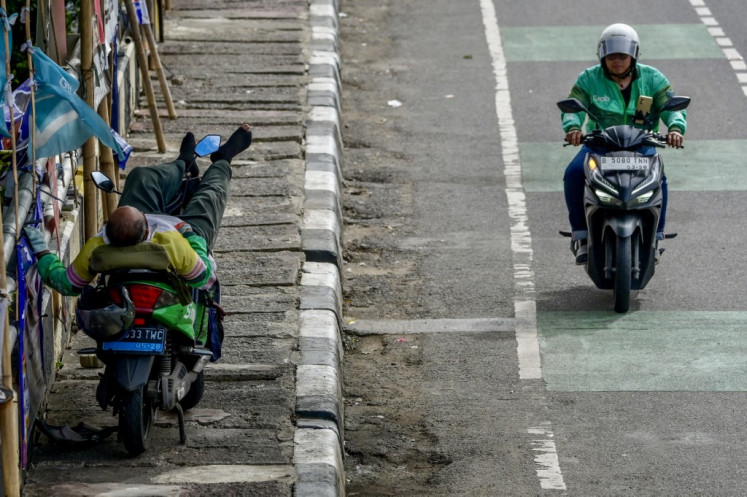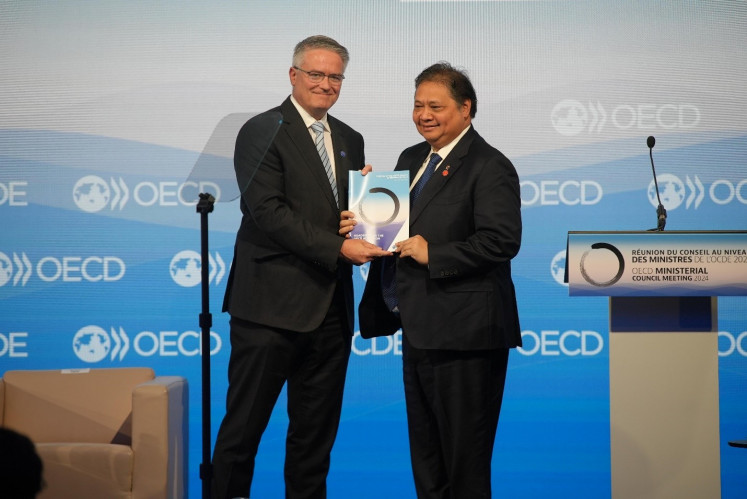What's so Indonesian about Indonesia anyway?
According to the judges, our newly-crowned Miss Indonesia, Karenina Sunny Halim, won her title largely because she amazed them with her fl uent English - mighty handy, of course, for representing Indonesia at international forums
Change Size

According to the judges, our newly-crowned Miss Indonesia, Karenina Sunny Halim, won her title largely because she amazed them with her fl uent English - mighty handy, of course, for representing Indonesia at international forums.
Unfortunately, there's just one big catch when she's not representing Indonesia at international forums: She doesn't speak Indonesian, nor does she know much about Indonesian culture.
She's half-American, uses English on a daily basis, and when she does give Indonesian a go, she does so haltingly and with an American accent.
This is all rather strange - another entry for my bulging "Only in Indonesia" fi le. I mean, can you imagine a Miss America who doesn't speak English, a Miss Brazil who doesn't speak Portuguese or a Miss Japan who doesn't speak Japanese?
Yes, Karenina's "Lost in Translation" victory is exactly the sort of thing guaranteed to send Presidential candidate Megawati and her running mate, Prabowo Subianto, into meltdown.
Their Tweedledum-Tweedledee campaign now seems to be pinning its slender hopes of victory on a protect-your-traditional-culture drive. Mega says "the fl ow of globalization into Indonesia is so fast . if we don't protect our culture, one day we'll fall on our faces".
Prabowo cites the number of foreign malls in Indonesia, saying that the Japanese prefer Japanese malls, and that Walmart closed there after fi ve years.
That's proof of Japanese nationalism, he said, and Indonesians should do likewise. (Of course! haven't we always striven to emulate our northern brother in the Asian co-prosperity sphere?)
Okay, so let's see if their fears are founded. What is Indonesian culture and is it being invaded by aliens?
Let's start with food, something we all love. Here's a short list of Indonesia's most famous traditional dishes: Gado-gado (mixed boiled veggies in peanut sauce), satay (chicken, beef or lamb skewers in peanut sauce or soya-sauce with chili), rendang (tasty morsels of meat simmered for hours in coconut milk, spices and lots of chili), belado (sliced fried meat, shrimp or potatoes in a chili and tomato sauce), and lots and lots of tofu and tempe dishes. Yummy! Am I making your mouth water?
But stop! Are these dishes really "Indonesian"? Chili peppers are from the Americas; tomatoes are from South America; potatoes originated from the Andes; and peanuts are native to South America, Mexico and Central America.
Like it or not, without Christopher Columbus, that alien Western globalizer, our national cuisine wouldn't exist!
So what is left? Surely coconut milk, the basic ingredient of so many Indonesian dishes, is native? Guess again: Its origins are controversial, and some claim coconuts come from South Asia, but fossil records show that they're from New Zealand. And soybeans?
They are used to make the tempe and tofu so beloved of Indonesians that when the price of soybeans skyrocketed in 1997-1998 during the monetary crisis, and again as recently as 2008, Indonesians were screaming not for blood, but for beans. Well, sorry, soybeans are still primarily imported.
Yep, most of our "traditional" recipes are just a complex blend of cultural infl uences: Chinese, Indian, Arab, Dutch, Spanish, Portuguese and Anglo.
Even our world-famous Indonesian Rijsttafel (rice table), a banquet of many dishes, was a Dutch colonial creation. Do you think that the average "inlander" (native) would have had the time and money to enjoy such a luxury?
They say you are what you eat, but what about what comes out of our mouths? Bahasa Indonesia is also a product of imports, including Sanskrit, Arabic, Persian, Chinese, Japanese, Tamil, Dutch, Portuguese and English.
In fact, there are so many loanwords from other languages (look up Wikipedia's entry on Loan words in Indonesian) that a book containing 20,000 of them, Russell Jones' Loan Words in Indonesian, was recently published.
What about what we believe? Hinduism and Buddhism, the two oldest religions in Indonesia, were brought in by Indian traders. Islam is from the Middle East, brought here by a host of ethnicities, including Gujarati traders and Chinese merchants.
The Portuguese brought Catholicism with them, and the Dutch Protestantism, while Confucianism came with Chinese merchants and immigrants. So, is there any native Indonesian belief system? Yes, animism, which everyone - from Muslims to Christians - has tried to marginalize.
How about clothing? Well, it's mainly Western, while traditional costumes have long been infl uenced by Chinese, Indian and (especially nowadays!) Arab cultures. Even the peci, the black cap that Sukarno and hundreds of others after him wear as a symbol of nationalism, is a take on the Turkish fez.
I could go on about theatre, dance, music, technology - and don't even get me started about our economic and political system - but it seems pretty clear that Indonesian cultures (yes, it's plural!) are a long-simmering stew of foreign infl uences.
And this is because Indonesia has always been a globalized society at a crossroads of nations, straddling as it does the sea lanes between India and China.
Our cities have thus always been entrepots, so it's hardly surprising that our communities are still syncretic and eclectic - a giant archipelagic bourse for cultures, religions and ideas.
Globalization is neither new nor scary, and certainly not a product of modernity. History, fi lled with conquests, commerce and (religious) conversions, has for centuries produced hugely successful globalized entrepots like Rome, Alexandria, Venice, Ottoman Istanbul ... and Jakarta.
Gado-gado without peanuts, sambal without chili, tempe without soybeans? Unimaginable right? In fact, without globalization and foreign infl uences, Indonesia itself is unimaginable.
We wouldn't have any of the offi cially-recognized religions, we wouldn't be speaking Bahasa Indonesia, and we'd have no coffee (from Ethiopia) or tea (from China) to chat over (our national pastime), and no stinky kreteks to smoke while doing so (tobacco is from America).
Even Balinese dancing girls would be unable to dance the (Indian) Ramayana or Mahabharata tales. And they couldn't even wear frangipani in their hair, either because that quintessentially tropical fl ower is - you guessed it! - another Latin America import.
So maybe Karenina is just another expression of our gloriously globalized and diverse community, and not so "un-Indonesian" after all? As for Mega-Pro, would someone be so kind as to give them a free lesson in globalization and the cultural history of our not-so traditional country?
The writer is the author of Julia's Jihad.









